For Advertising Contact Us
Personal Finance Slide Presentation Project

A personal finance slide presentation project is an excellent way to communicate essential financial concepts, whether for personal learning, teaching, or presenting at a workshop. The key to creating an effective slide presentation is to keep the information concise, easy to understand, and visually appealing. This article will guide you through the steps of creating a comprehensive personal finance slide presentation.
What is Personal Finance?
Personal finance refers to managing your own or your family’s financial activities. It covers areas like budgeting, saving, investing, and planning for the future. Understanding personal finance allows you to make informed decisions about how you spend, save, and grow your money.
Importance of Personal Finance
Understanding personal finance helps you:
- Control your spending
- Plan for the future
- Build wealth
- Reduce financial stress
Mastering these concepts can lead to financial independence.
Why Create a Personal Finance Slide Presentation?
A personal finance slide presentation is a great way to organize and share financial information. Whether you’re a student, a teacher, or someone who wants to improve their financial literacy, creating a slide presentation is an effective method to break down complex ideas into digestible chunks.
Benefits of a Personal Finance Slide Presentation
- Visual learning tool
- Simplifies complex concepts
- Engages your audience
- Encourages retention of key financial principles
Steps to Create a Personal Finance Slide Presentation
1. Define the Goal of Your Presentation
Before you start designing your slides, be clear about your goal. Are you educating, inspiring, or teaching a specific financial strategy?
- Audience: Are they beginners or advanced in personal finance?
- Topic: Will you cover budgeting, debt management, or investing?
2. Structure Your Content
Break your presentation into key sections:
- Introduction to personal finance
- Key financial concepts like budgeting, saving, and investing
- Practical tips for managing finances
- Conclusion and actionable steps
3. Use Visuals to Support Your Points
Visuals help keep your audience engaged. Use graphs, charts, and images to make your presentation appealing and understandable. For example:
- A pie chart showing how to allocate income
- A bar graph comparing the growth of different investment options
4. Keep Your Slides Simple and Clear
Each slide should focus on one idea at a time. Avoid clutter. Too much text can overwhelm your audience, so aim for short bullet points and highlight key concepts.
Essential Topics to Include in Your Slide Presentation
1. Budgeting
Budgeting is the cornerstone of personal finance. Teach your audience how to create a simple budget by categorizing income and expenses.
- Example: A monthly budget template with different spending categories.
2. Saving
Explain the importance of saving money for emergencies, big purchases, and future goals.
- Example: An emergency fund graphic showing how much to save based on income.
3. Debt Management
Offer strategies to pay down debt, such as the debt snowball or avalanche method.
- Example: A comparison chart of paying off high-interest vs. low-interest debts.
4. Investing
Explain how investing can help grow wealth over time. Use charts to show how compound interest works.
- Example: A line graph demonstrating investment growth over 10 years.
Optimizing Your Personal Finance Slide Presentation
To make your presentation stand out, follow these optimization tips:
Use Engaging Design
Select a clean, professional design that complements your content. Choose fonts that are easy to read, and stick to a consistent color scheme throughout.
Add Interactive Elements
If you’re presenting live, engage your audience by asking questions or including a quiz at the end of the presentation.
Rehearse Your Presentation
Rehearse multiple times before the actual presentation to ensure smooth delivery and to adjust pacing.
Wrapping Up
A personal finance slide presentation project is an impactful way to learn and teach crucial financial concepts. By following these steps, you’ll create an informative and visually engaging presentation. Remember to keep the slides simple, focus on the most essential points, and use visuals to make complex topics easier to understand.



